
Ladin is a Romance language of the Rhaeto-Romance subgroup, mainly spoken in the Dolomite Mountains in Northern Italy in the provinces of South Tyrol, Trentino, and Belluno, by the Ladin people. It exhibits similarities to Romansh, spoken in Switzerland, as well as Friulian, spoken in north-east Italy.

Cimbrian is any of several local Upper German varieties spoken in parts of the Italian regions of Trentino and Veneto. The speakers of the language are known as Zimbern in German.
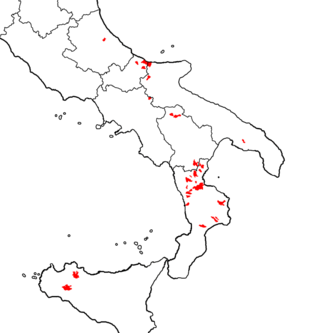
The Arbëreshë, also known as Albanians of Italy or Italo-Albanians, are an Albanian ethnolinguistic group minority historically settled in Southern and Insular Italy.

Mòcheno is an Upper German variety spoken in three towns of the Bersntol, in Trentino, northeastern Italy.

Asiago is a minor township with the title of city in the surrounding plateau region in the Province of Vicenza in the Veneto region of Northeastern Italy. It is near the border between the Veneto and Trentino-Alto Adige/Südtirol regions in the foothills of the Alps, approximately equidistant (60 km) from Trento to the west and Vicenza to the south. The Asiago region is the origin of Asiago cheese. The town was the site of a major battle between Austrian and Italian forces on the Alpine Front of World War I. It is a major ski resort destination, and the site of the Astrophysical Observatory of Asiago, operated by the University of Padua.

The province of Trieste is a province in the autonomous Friuli-Venezia Giulia region of Italy. Its capital was the city of Trieste. It had an area of 212 square kilometres (82 sq mi) and it had a total population of 234,668. It had a coastal length of 48.1 kilometres (29.9 mi). Abolished in 2017, it was reestablished in 2019 as the regional decentralization entity of Trieste, and was reactivated on 1 July 2020.

Provincia autonoma di Trento, commonly known as Trentino, is an autonomous province of Italy in the country's far north. Trentino and South Tyrol constitute the region of Trentino-Alto Adige/Südtirol, an autonomous region under the constitution. The province is composed of 166 comuni. Its capital is the city of Trento (Trent). The province covers an area of more than 6,000 km2 (2,300 sq mi), with a total population of 541,098 in 2019. Trentino is renowned for its mountains, such as the Dolomites, which are part of the Alps.

Aviano is a town and comune (municipality) in the Regional decentralization entity of Pordenone at the foot of the Dolomites mountain range in Friuli-Venezia Giulia, northeast Italy.
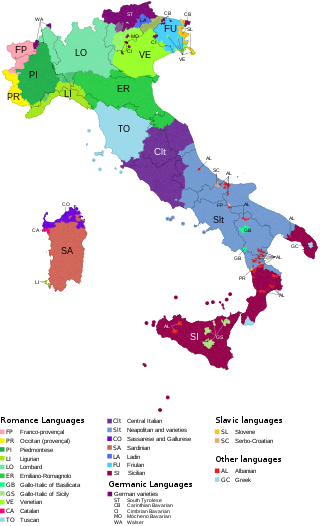
The languages of Italy include Italian, which serves as the country's national language, in its standard and regional forms, as well as numerous local and regional languages, most of which, like Italian, belong to the broader Romance group. The majority of languages often labeled as regional are distributed in a continuum across the regions' administrative boundaries, with speakers from one locale within a single region being typically aware of the features distinguishing their own variety from one of the other places nearby.

Luserna is a comune (municipality) in Trentino in the northern Italian region Trentino-Alto Adige/Südtirol, located about 25 kilometres (16 mi) southeast of Trento. As 2021, it had a population of 271 and an area of 8.2 square kilometres (3.2 sq mi).
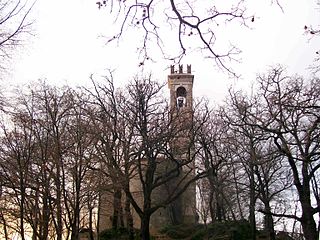
Badia Calavena is a comune (municipality) in the Province of Verona in the state Veneto, located about 90 kilometres (56 mi) west of Venice and about 20 kilometres (12 mi) northeast of Verona. It is part of the Thirteen Communities, a group of villages which historically speak the Cimbrian language.

Bosco Chiesanuova is a comune (municipality) in the Province of Verona in the Italian region Veneto, located about 100 kilometres (62 mi) west of Venice and about 20 kilometres (12 mi) north of Verona. It is part of the Thirteen Communities, a group of villages which historically speak the Cimbrian language.
Erbezzo is a comune (municipality) in the Province of Verona in the Italian region Veneto, located about 100 kilometres (62 mi) west of Venice and about 25 kilometres (16 mi) north of Verona. As of 31 December 2004, it had a population of 809 and an area of 32.4 square kilometres (12.5 sq mi). It is part of the Thirteen Communities, a group of villages which historically speak the Cimbrian language.
Roveré Veronese is a comune (municipality) in the Province of Verona in the Italian region Veneto, located about 100 kilometres (62 mi) west of Venice and about 20 kilometres (12 mi) northeast of Verona. It is part of the Thirteen Communities, a group of villages which historically speak the Cimbrian language.

San Mauro di Saline is a comune (municipality) in the Province of Verona in the Italian region Veneto, located about 90 kilometres (56 mi) west of Venice and about 20 kilometres (12 mi) northeast of Verona. It is part of the Thirteen Communities, a group of villages which historically speak the Cimbrian language.

Velo Veronese is a comune (municipality) in the Province of Verona in the Italian region Veneto, located about 100 kilometres (62 mi) west of Venice and about 20 kilometres (12 mi) northeast of Verona. It is part of the Thirteen Communities, a group of communities which historically speak the Cimbrian language.

Sauris is a comune (municipality) in the Regional decentralization entity of Udine in the Italian region of Friuli-Venezia Giulia. At an elevation of 1,212 m (3,976 ft), it is the second highest municipality in the region and one of the German language islands in Northeast Italy. Sauris is part of the Alpine pearls cooperation for sustainable tourism.
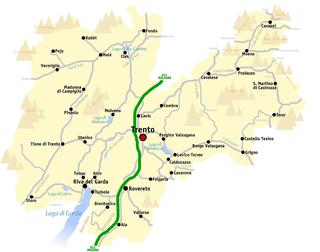
The list shows the municipalities (comuni) of the autonomous province of Trento, Italy. Trentino is divided into 176 administrative subdivisions (Comuni/Gemeinden). Some municipalities have a second official language such as German and Ladin. Most German names of municipalities however are historical apart from the previously mentioned communities. The Ladin variety of the Fassa Valley is currently the only officially recognized one, in contrast to the varieties of Non and Sole Valley).
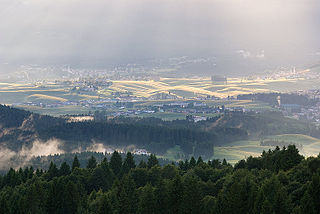
The Sette Comuni are seven comuni that formed a Cimbrian enclave in the Veneto region of north-east Italy. The area is also known as the Altopiano dei Sette Comuni or Asiago Plateau, and it was the site of many battles during World War I. The most important comune is that of Asiago, for which Asiago cheese is named. Cimbrian, a dialect of Upper German, was the native tongue, and the area was ethnically and culturally distinct from the surrounding comuni. The Sette Comuni are located in mountainous territory, ranging from 500 to 2300 metres above sea level.

The town Giazza is a frazione of the comune of Selva di Progno, in the Province of Verona.


















